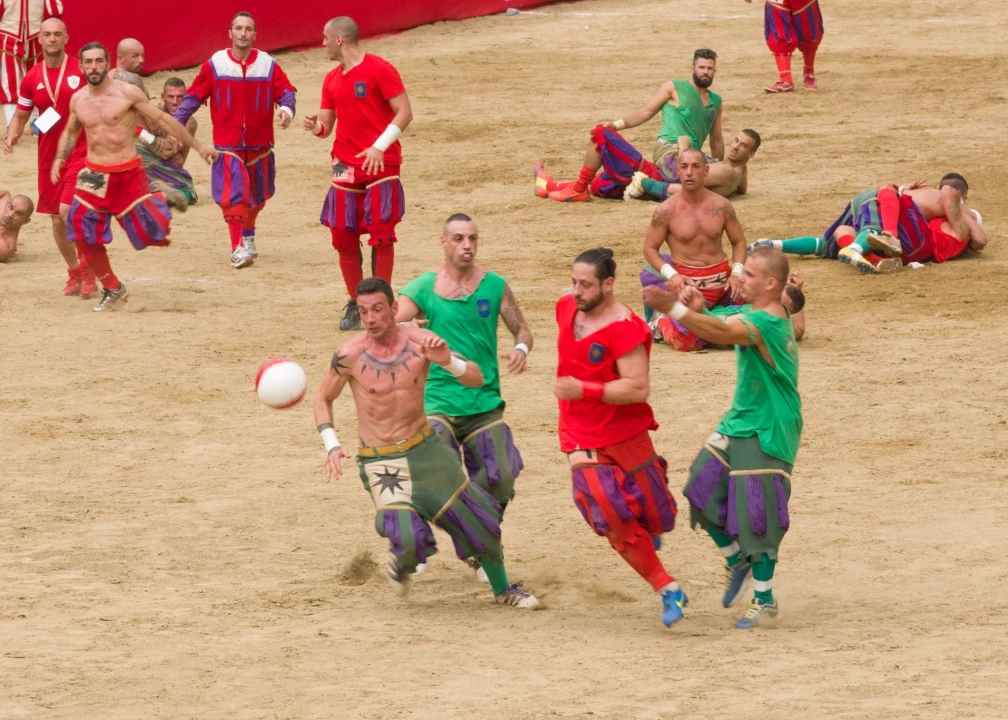Soccer is the greatest passion of the Italians. In every small town throughout the peninsula there is a soccer team. Soccer is played in the courtyards of buildings, in those of churches, and still today, in small towns, even on the street. Every child in Italy is born with a ball between his feet and a team to cheer for. Soccer is the national sport, also as far as business is concerned, because in Italy it is a real industry that gives work to thousands of people and generates important turnover.
There is a city, however, where soccer has very ancient roots and represents something much more important. It is Florence, one of the most famous and loved art cities in the world. More than 500 years ago, the Florentines started playing in the squares with a ball. They were so in love with the game, which was not regulated like today's soccer, that on February 17, 1530, in Piazza Santa Croce, a group of young people challenged each other despite the fact that the city was invaded by military troops sent by the King of Spain, Charles V of Habsburg, with the intention of bringing the Medici dynasty back in command of the city. A challenge that has remained in history, because that day is remembered as the beginning of the long history of "Florentine soccer".
What is it about? For historians it is considered the "father" of Italian soccer and partly also of rugby (and thus, even American Football), because you play with a ball, but you use your hands and feet and tackle your opponents. Indeed, the ferocity with which the players of the two teams face each other with punches, pushes, kicks, landings, has made it a sort of legendary sport nowadays. Also known as "soccer in costume", the rules were written in 1580 by the Florentine scholar and nobleman Giovanni Bardi. There were 33 rules, which describe the place to play, the period and times of the challenges, the opening ceremony of the games, the number of players and the roles, up to the detailed rules of the game.
Rules that still today, for the most part, are adopted by those few citizens of Florence who have the privilege to participate in the annual match, a real event for the city. From that first match almost 500 years ago to today, historical Florentine soccer has not always been played. For 200 years, until 1739, there are reports of matches that took place in Florence. Then for another 200 years there are no traces but from a couple of matches recorded at the end of the 1800s and the beginning of the 1900s.
The most extreme soccer challenge in the world has been taking place regularly since 1930, with the four teams of players (they are called "calcianti", different from the actual soccer players who are called “calciatori”) representing the historic districts of Florence who compete in four fierce matches every year.
Florentine soccer is like a tribal ceremonial for the Florentines. It has its ancient rules, its rituals before, during and after the matches, and the charm of the Renaissance period that made Florence one of the places of maximum artistic and architectural expression in the world.
The four participating teams, the "bianchi" (white, Santo Spirito neighborhood), the "azzurri" (blue, Santa Croce district), the "rossi" (reds, Santa Maria Novella district) and the "verdi" (greens, San Giovanni district), composed of 27 "calcianti", train all year round between gym and soccer fields in their neighborhood. They do it for free, after work, without earning even one euro. A year of hard training, and then only one or two matches in Piazza Santa Croce.
They play wearing a Renaissance style costume, composed only of pants and shoes because on the field, or rather in the arena made of earth and fenced like a cage, they go down without a shirt. Each team is made up of groups of players divided into three roles: the "sconciatori", the "datori" and the "corridori". All together have only one task, that of scoring in the opponent's goal which is as wide as the whole short side of the field.
To do so, the players can use any means to advance or stop the opponents. Kicks, punches, landings: in short, in the 50 minutes of battle on the field chaos is created. They look more like gladiators who entered the Colosseum to face each other or to fight with ferocious animals. And the whole city participates in the ritual, which begins with the costume parade through the streets of the neighborhoods until the arrival on the playing field.
The ancient charm of "Florentine soccer" is still current and is also due to the many famous people who played as "calcianti". The nobles Piero II de' Medici, Lorenzo II de' Medici, Alessandro de' Medici, Cosimo I de' Medici, Francesco I de' Medici and Vincenzo Gonzaga, for example, and also three future popes: Giulio de' Medici (Pope Clement VII), Alessandro de' Medici (Pope Leo XI) and Maffeo Barberini (Pope Urban VIII).
Over the centuries, this sport has become so famous that it has travelled around the world to celebrate important occasions.
In 1570, for example, it was played at the Baths of Diocletian in Rome to celebrate the nomination as Grand Duke of Cosimo I de' Medici. In 1575 in Lyon, France, in honor of King Henry III who was visiting the city. In 1960 still in Rome on the occasion of the Summer Olympic Games. On October 12, 1976 in New York on the occasion of Columbus Day. In 1998 still in Lyon on the occasion of the Soccer World Cup.
But in the end, since five hundred years ago, 27 "calcianti" take to the field to win the challenge against other 27 "calcianti", all from Florence, just to defend the honor of their neighborhood. In our opinion, this is the charm of this unique sport in the world.




